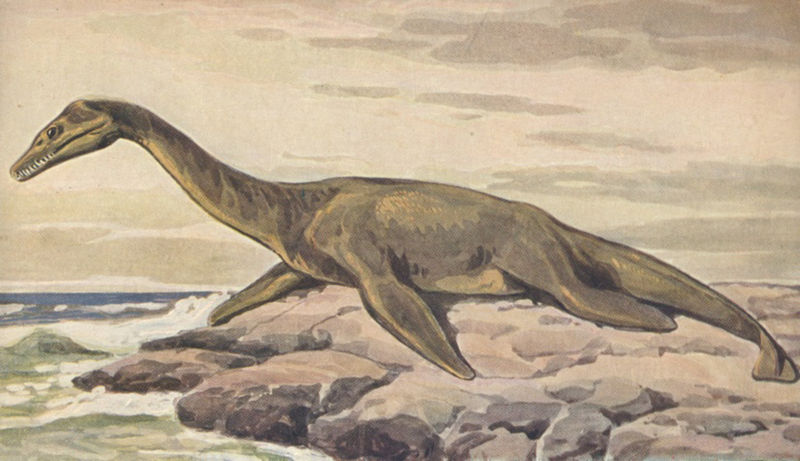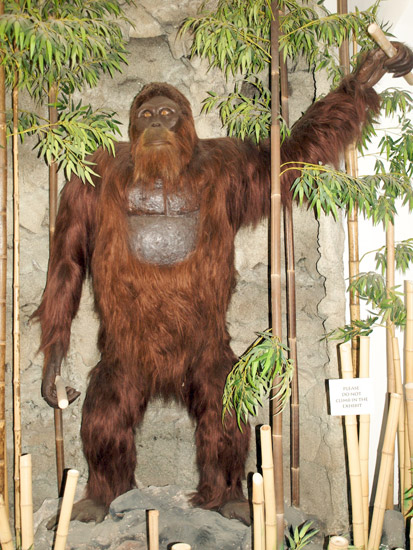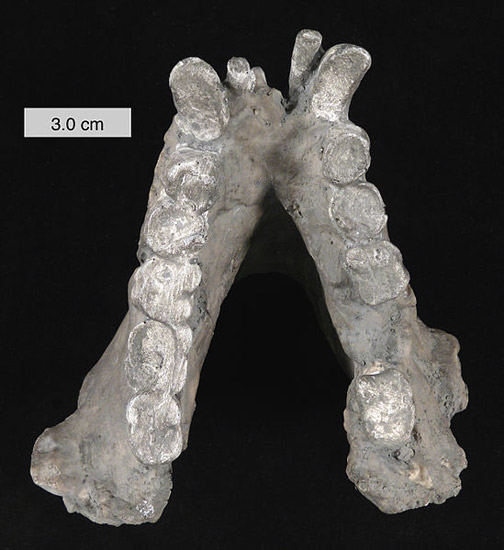August 23, 2012 9:00 am
Celebrating 1,447 Years of the Loch Ness Monster

An artist’s depiction of a Plesiosaur, the same species Nessie reportedly belongs to. Photo: The Berlin Aquarium
Yesterday, 1,447 years ago the Gaelic Irish missionary monk Saint Columba was poking around the Scottish highlands when he reportedly stumbled upon a creature no man had before seen: an ancient, long-surviving plesiosaurs, better known now as the Loch Ness monster. According to Adomnan, the ninth Abbot of Iona who later recorded Columba’s adventures, the Saint came upon a group of locals digging a grave for a man recently killed by a monster said to inhabit the River Ness. All fired up, Columba took off for the river and promptly saved a swimmer from the monster by invoking the sign of the cross and declaring, “Thou shalt go no further, nor touch the man; go back with all speed.” The beast halted as if it were “pulled back with ropes” and fled in terror. Columba saved the swimmer and won over a few converts from the grateful villagers.
Thus, the legend of the Loch Ness monster was born. Of course, the fact that Adomnan also recounts adventures in which Columba calms storms, expels evil spirits and raises people from the dead made no impact on the legend’s believability, nor did the fact that Medieval water monster stories were a favorite gimmick used to instil the fear of God in quaking believers. And somewhere through the passings on of local lore, Loch Ness, Scotland’s second-largest loch, or lake, took over as the monster’s home rather than the originally reported River Ness, which runs off the lake.
After the Saint’s close call, the monster was not “spotted” for another 1,368 years, when Mr. and Mrs. George Spicer reported seeing “a most extraordinary form of animal” cross the road in front of their car on July 22, 1933. According to their account, the creature was about 25 feet long and 4 feet high, with a long, spotted neck that resembled a thick elephant trunk.
Their account sparked a frenzy of similar sightings, including hunting parties determined to catch the animal “dead or alive.” As technology developed, so too did the various ways in which people tried to depict the monster, including by film, video or sonar. Later analysis revealed each one to be a creatively staged hoax.
Just in time for Nessie’s anniversary, however, a new photo – the “best yet” – emerged. ABC news reports:
George Edwards takes his boat, “Nessie Hunter,” out onto Loch Ness nearly every day, often with tourists who hope to see the creature for themselves. Early one morning in November of last year, Edwards was turning his ship back to shore after spending the morning searching for an old steam engine on the lake floor, when he saw something else.
“I saw something out of the corner of my eye, and immediately grabbed my camera,” Edwards told ABC News. “I happened to get a good picture of one of them.”
Edwards said he watched the creature for about 10 minutes, but does not explain why he only snapped one photo during that window.
Rival Loch Ness monster enthusiast Steve Felthman already called foul and debunked the photo to STV News:
He says he is convinced Mr Edwards took the picture during the filming of a documentary on the monster which he participated in, and has sourced the film’s fake fibreglass hump which he believes is the star of Mr Edwards’ snap.
Mr Feltham said: “There’s absolutely no doubt that this is the same thing. Look at the step slope on the front – it’s got several ridges on it. The number of ridges is the same as on the model.
Edwards countered, claiming to know nothing about any fake hump although admitting Feltham is “entitled to his opinion.” Even at 1,447 years old, the legend of the Loch Ness monster just keeps on giving.
More from Smithsonian.com:
August 17, 2012 11:00 am
Yes, We’re Actually Still Looking for the Yeti

Bring me to your yeti leader, and I’ll test its DNA. Image: tolomea
Many scientists make their careers out of searching for the seemingly unfindable. The Higgs Boson, dark matter, the secret, hidden pieces of our universe. Other scientists search for things that probably aren’t real at all. Like yetis. Researchers are about to embark on a quest to determine once and for all whether or not Yetis exist.
That’s right, a Yeti hunt. It’s got a fancier name – the Oxford-Lausanne Collateral Hominid Project – but it’s a serious, scientific, Yeti hunt.
The project focuses on DNA analysis. They’re accepting submissions of samples from pretty much anyone who thinks they have evidence of a Yeti. People send the material in to them, where it’s tested for DNA. That DNA can tell them a whole lot about whether the mythical beast exists.
Now, there have in fact been DNA tests on supposed Yeti samples before. Every time they’ve come back as being human. But DNA techniques have gotten better, and the scientists are willing to give it one last go. Well, at least some of them. BBC Futures sums up the scientific atmosphere:
It is likely that the project is the biggest and most comprehensive attempt yet to probe suspected “remains”. “Nothing like this, on this level, has been done before,” says Richard Freeman from the Centre for Fortean Zoology in the UK. But therein lies the rub. For people like Freeman who devote their lives to looking for these creatures, it is the biggest signal yet that after years out in the cold mainstream science is finally taking the seriously. But for some scientists, the whole venture is an embarrassing curiosity to be held at arm’s length.
One of the scientists involved in the project, Bryan Sykes, sees this as a catch all for those who claim science brushes them off. ““It’s one of the claims by cryptozoologists that science does not take them seriously. Well, this is their chance. We are calling for people to send us their evidence, and we will test it through DNA analysis,” he told the BBC.
This DNA evidence will certainly not be a nail in any sort of Yeti coffin. Even if they find no evidence whatsoever of the yeti, many will still believe. Last year, the Huffington Post reported that some scientists were “95 percent certain” that they had found evidence of the Yeti. Before that, bigfoot “researchers” asked people in California for money to test whether the creature left residue behind on a pickup truck.
Even the director of the International Cryptozoology Museum is skeptical of many of these claims. He told The Huffington Post:
“This does not seem to be any more than what you hear about from weekend excursions in North America that go out, discovering some hair of undetermined origin, calling it ‘Bigfoot hair,’ then locating some broken branches and piled trees, saying it was made by Bigfoot, and finding footprints that look like Sasquatch tracks. These are not ‘proof’ that would hold up, zoologically.”
But even for Sykes, the geneticist behind the project, this is all a bit far fetched. He’s not ruling out the possibility of a new species – we discover new species all the time, many of them quite large. But he acknowledges that there will need to be some evidence. The BBC says, “he is also keen to point out that he is not – nor intends to become – a cryptozoologist. ‘I don’t not want to become completely eccentric,’ he adds.”
More at Smithsonian.com:
January 9, 2012
Did Bigfoot Really Exist? How Gigantopithecus Became Extinct
Bigfoot. Sasquatch. Yeti. The Abominable Snowman. Whatever you want to call it, such a giant, mythical ape is not real—at least, not anymore. But more than a million years ago, an ape as big as a polar bear lived in South Asia, until going extinct 300,000 years ago.
Scientists first learned of Gigantopithecus in 1935, when Ralph von Koenigswald, a German paleoanthropologist, walked into a pharmacy in Hong Kong and found an unusually large primate molar for sale. Since then, researchers have collected hundreds of Gigantopithecus teeth and several jaws in China, Vietnam and India. Based on these fossils, it appears Gigantopithecus was closely related to modern orangutans and Sivapithecus, an ape that lived in Asia about 12 to 8 million years ago. With only dentition to go on, it’s hard to piece together what this animal was like. But based on comparisons with gorillas and other modern apes, researchers estimate Gigantopithecus stood more than 10 feet tall and weighed 1,200 pounds (at most, gorillas only weigh 400 pounds). Given their size, they probably lived on the ground, walking on their fists like modern orangutans.
Fortunately, fossil teeth do have a lot to say about an animal’s diet. And the teeth of Gigantopithecus also provide clues to why the ape disappeared.
The features of the dentition—large, flat molars, thick dental enamel, a deep, massive jaw—indicate Gigantopithecus probably ate tough, fibrous plants (similar to Paranthropus). More evidence came in 1990, when Russell Ciochon, a biological anthropologist at the University of Iowa, and colleagues (PDF) placed samples of the ape’s teeth under a scanning electron microscope to look for opal phytoliths, microscopic silica structures that form in plant cells. Based on the types of phyoliths the researchers found stuck to the teeth, they concluded Gigantopithecus had a mixed diet of fruits and seeds from the fig family Moraceae and some kind of grasses, probably bamboo. The combination of tough and sugary foods helps explain why so many of the giant ape’s teeth were riddled with cavities. And numerous pits on Gigantopithecus‘s teeth—a sign of incomplete dental development caused by malnuntrition or food shortages—corroborate the bamboo diet. Ciochon’s team noted bamboo species today periodically experience mass die-offs, which affect the health of pandas. The same thing could have happened to Gigantopithecus.
Further evidence of Gigantopithecus‘ food preferences and habitat was published last November. Zhao LingXia of the Chinese Academy of Sciences and colleagues analyzed carbon isotopes in a sample of Gigantopithecus teeth. Plants have different forms of carbon based on their type of photosynthesis; this carbon footprint is then recorded in the teeth of animals that eat plants. The team determined Gigantopithecus—and the animals living alongside it, such as deer, horses and bears—ate only C3 plants, evidence the ape lived in a forested environment. This work also supports the proposed bamboo diet, as bamboo is a C3 plant.
So what happened to this Pleistocene Yeti? Zhang’s team suggested the rise of the Tibetan plateau 1.6 million to 800,000 years ago altered the climate of South Asia, ushering in a colder, drier period when forests shrank. Other factors could have exacerbated this crisis. Gigantopithecus‘s neighbor, Homo erectus, may have over-hunted and/or outcompeted their larger ape cousin. And at least one dental study indicates Gigantopithecus developed and matured very slowly—a sign they probably had low reproductive rates, which can elevate a species’ risk of going extinct.
Some Bigfoot hunters say Gigantopithecus is alive and well, hiding out in the forests of the Pacific Northwest. Other Sasquatch enthusiasts, however, point out this is unlikely, as Bigfoot is reported to be a swift, agile, upright walker—not a lumbering, 1,200-pound quadruped.
[The concept of Giganto as a 1200 pound quadruped is also strictly imaginary without any real supporting evidence at present-DD]



That last section is awful, really badly written.Firstly who says the yeti is 'mythical'?
ReplyDeleteSecondly, the shape of the lower jaw suggests a biped rather than a knuckle walker.
I am in full agreement with you on both of those points. Unfortunately that is the sort of thing we're always up against. It would really help if they even bothered to define what "Yeti" it is that they are supposed to be talking about (the initial footprint reports were "Bigfoot" footprint reports BTW)
ReplyDeleteWhat are your thoughts on the Paranthropus theory for Bigfoot? I too suport the Gigantopithecus theory but I would like to hear your thoughts.
ReplyDeleteBest Wishes,
Noah Eckenrode,
Amateur Cryptozoologist
Tyler Stone has some exellent reviews of my theories and posted them on his blog: why dont you go over to his blog and look them over? The main distinctions I make counter to Tyler Stone's assessments are to decrease the number of actual species involved. My arrangement is therefore more parsimonious. If you still wish to know more about what I have already published as my private opinions on the matter, I can easily provide you with the links. But you really should use the indexed headings to the side of the blog pages.
ReplyDeleteBest Wishes,
Dale D.
Delete